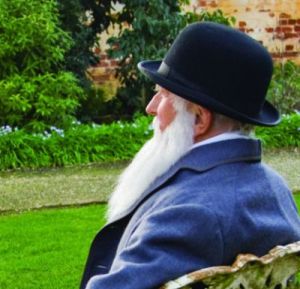Focus: creation news and views

World’s oldest spider web?
Two brothers, Jamie and Jonathan Hiscocks, found what is claimed to be the world’s oldest spider’s web, supposedly spun in the dinosaur era 140 million years ago. They found the web encased in amber on a beach at Bexhill, East Sussex. As the cliff erodes, the fossils fall from the rocks and lie on the beach, waiting to be collected. The fossils are at least as old as the cliff strata.
Early images, taken by a paleobiologist at Oxford University, show that the threads in the amber resemble silk spun by modern spiders. Scientists expressed surprise that spider webs have stayed the same for 140 million years. What is more amazing is that they don’t question the tangled web of millions-of-years when caught by spider evidence like this.
- BBC News, news.bbc.co.uk/2/hi/uk_news/england/sussex/7925629.stm, 5 March 2009.
- National Geographic News, news.nationalgeographic.com/news/2008/12/081216-oldest-web-photo.html, 16 December 2008.
Prescription for raising children

A study by the Mapping America project has found that children have fewer behavioural problems at school and home when they live with both biological parents and attend church frequently. They are five times less likely to repeat a grade, and more likely to be cooperative and understanding of others’ feelings.
The report says: “Parents of these children report less stress, healthier parent-child relationships, and fewer concerns about their children’s achievement. These differences hold up even after controlling for family income and poverty, low parent education levels, and race and ethnicity.”
Of course! The biological family is God’s prescription for the proper and best way of raising children. The fact that in the beginning God made but one man and one woman shows that He intended that marriage should be monogamous and indissoluble (Genesis 2:18; Matthew 19:3–9; see also p. 12). And it is within this setting that God blessed the world’s first parents and said, “Be fruitful and increase in number … ” (Genesis 1:28). Cf. “Children are a heritage of the Lord” (Psalm 127:3–5).
One purpose of God in instituting families is seen in God’s instructions to parents to teach their children about God and His Word (Deuteronomy 4:10, 6:6–7), in order to produce “godly offspring” (Malachi 2:15). When parents follow the Manufacturer’s instructions it is little wonder that these children have a huge advantage.
- LifeSiteNews.com, www.lifesitenews.com/ldn/2008/dec/08121702.html, 17 December 2008.
BBC agenda
In May 2009, the BBC appointed a Muslim, Aaquil Ahmed, as its head of religious programming, in a radical departure from broadcasting tradition. According to the Daily Telegraph, senior bishops wrote to the BBC’s Director-General Mark Thompson when the appointment was envisaged, to question the BBC’s commitment to Britain’s Christian viewers. Obviously to no avail. This follows the appointment last year of a Sikh, Tommy Nagra, as executive producer of BBC-1’s popular Songs of Praise.
Interestingly, in the last census in the UK, 71.8% of the population aligned themselves with Christianity, only 2.8% said they were Muslims, and a miniscule 0.6% said they were Sikhs.
It would seem that the BBC’s anti-Christian agenda is becoming increasingly obvious. (See also creation.com/bbc-noah.)
- Daily Telegraph (UK), www.telegraph.co.uk/culture/tvandradio/5331369/BBC-receives-115-complaints-over-Muslim-head-of-religious-programming-Aaqil-Ahmed.html, 16 May 2009.
Adult stem cells in contact lens cure cornea damage

The cornea is the transparent outer window of the eye, which also provides about two-thirds of the focusing. So corneal damage is a major cause of blindness. But now, researchers from the University of New South Wales, Australia, have invented a new way to use adult stem cells to repair corneas in three patients. They extracted stem cells from the undamaged eye and cultured them on a contact lens, which was then stuck onto the damaged cornea. After 10 days, the stem cells had colonized the cornea, and produced transparent corneal tissue.
All three patients had notable visual improvement—this included one where the stem cells came from the conjunctiva rather than the cornea.
Lead researcher Dr Nick Di Girolamo said, “The procedure is totally simple and cheap. Unlike other techniques, it requires no foreign human or animal products, only the patient’s own serum, and is completely non-invasive. … There’s no suturing, there is no major operation: all that’s involved is harvesting a minute amount—less than a milli metre—of tissue from the ocular surface.”
This is just one of many proven treatments from adult stem cell research. Conversely, the much touted embryonic stem cells, which require destruction of human embryos, have yet to provide a single cure. See also creation.com/stem_cells.
- Science Daily, www.sciencedaily.com/releases/2009/06/090605081151.htm, 5 June 2009.
- Transplantation 87(10):1571, 27 May 2009.
Forensic science’s wrongful convictions

A report from the US National Academy of Sciences questions the reliability of using forensic techniques like hair or fingerprint analysis to link a person to a crime. Underlying such concerns is the fact that since 1992, DNA testing has exonerated 232 people previously convicted in American courts. “Faulty interpretation” of forensic evidence is said to have contributed to about 50% of the wrongful convictions.
Critics of the report are worried that the report will lead to over-emphasis of DNA evidence in crime investigations. They warn that DNA evidence is also “open to interpretation”, pointing out cases where it has gone wrong.
While forensic evidence can be crucial, an inappropriate emphasis on it to the exclusion of eyewitness evidence stands in stark contrast to the Bible (cf. Deuteronomy 19:15: “a matter must be established by the testimony of two or three witnesses”). In recent years some people have been wrongly convicted on the basis of interpreting forensic evidence alone, i.e. without eyewitness testimony. In the famous case of Australia’s Lindy Chamberlain (who was later exonerated), forensic “evidence” overruled eyewitness testimony that her baby was alive after the time at which the Crown Prosecutor claimed Lindy had murdered her. (See creation.com/dingo.)
It’s similar when it comes to the matter of how the world began. “Forensic” evidence, which can be interpreted in many ways, has been inappropriately used to support ideas about a supposed big bang, molten earth, primordial slime, dinosaur age, etc., overruling the eyewitness testimony of the Bible, which gives a very different account.
- New Scientist 201(2697):3, 6–7, 28 February 2009.
Mount of Olives jar handle

Construction workers excavating a building site on Jerusalem’s Mount of Olives have uncovered what archaeologists say is a jar handle dated to around 900 BC. The handle is inscribed with the Hebrew name Menachem (2 Kings 15:16–22).
Ron Beeri, of the Israel Antiquities Authority, said it is the first time an artefact bearing the name has been unearthed in Jerusalem. “It’s important because it shows that they actually used the name Menachem during that period,” he said. “It’s not just from the Bible, but it’s also in the archaeological record.”
We should not be surprised at this. As Clifford Wilson, a former director of the Australian Institute of Archaeology, has quipped, “The Bible is the most accurate history textbook the world has ever seen.” (See creation.com/archaeology.)
- MSNBC News, www.msnbc.msn.com/id/30844981, 20 May 2009.
Viruses help fight cancer
Viruses are particles so tiny that they can’t be seen by an ordinary light microscope, but only under an electron microscope. They are not living organisms because they cannot reproduce on their own, but need to hijack the machinery of true living cells. It’s thus not surprising that they cause many diseases.
Yet they are quite complex, even having a powerful electric motor to wind up their DNA (see creation.com/virusmotor). Clearly they are designed, so obviously must have once had beneficial functions before the Fall. We even see many such beneficial functions today (see creation.com/viruses).
New research suggests another possible pre-Fall function: preventing tumours. Canadian firm Oncolytics Biotech has made a new drug Reolysin, which is really not a drug but a reovirus. Already clinical trials have shown some tumours shrinking and in one case disappearing altogether.
- Daily Mail, www.dailymail.co.uk/health/article-1191454/The-bug-blast-away-cancer-Drug-virus-extends-patients-lives.html, 9 June 2009.

Skippy surprises scientists
Feeling jumpy? It may not be from what you think. Researchers at Australia’s government-backed Centre of Excellence for Kangaroo Genomics have mapped the genetic code of these marsupials, and were surprised at the amazing similarity to that of humans.
The Centre’s Director, Jenny Graves, said, “There is great chunks of the human genome which is sitting right there in the kangaroo genome.” In fact, according to a report in Australia’s national newspaper, the 20,000 genes in the kangaroo (roughly the same number as in humans) are “largely the same” as in people. Graves said elsewhere that “a lot of them are in the same order”.

The reports made no mention of the percentage similarity. It sounds like it would be extremely high—perhaps embarrassingly so, given that unlike chimps, kangaroos are not supposed to be our “close relatives”.
Looking at the huge outward differences between us and roos, it is obvious that the same gene must be able to make quite different proteins. But then, that should already have been obvious from the fact that despite people having only 20,000–25,000 genes, our bodies can make about 100,000 different proteins.
Evolutionists have long proclaimed that apes and people share a high percentage of DNA. Hence their surprise at these findings that “Skippy” has a genetic makeup similar to ours. But even granted that chimps and humans have a high degree of shared DNA (progressively being revised downward as genomic knowledge increases), even if it were 90%, would that make them 90% human, as most interpret this? It is worth repeating what prominent evolutionist/geneticist Steve Jones has said in the context of man/chimp DNA similarity: “We also share about 50% of our DNA with bananas and that doesn’t make us half bananas, either from the waist up or the waist down.”
This discovery, as with so many previous awkward discoveries (i.e. awkward for evolution), will no doubt end up displaying the ingenuity of evolutionists in making any fact, predicted or not, fit their materialistic worldview. Meanwhile, it showcases a much more incredible ingenuity for those with eyes to see—that of the Creator in coding a vast variety of creatures with such amazing compactness. (See also creation.com/homologous.)
- The Australian, www.theaustralian.news.com.au/story/0,25197,24671699-27703,00.html, 19 November 2008.
- Reuters, www.reuters.com/article/scienceNews/idUSTRE4AH1P020081118, 18 November 2008.

Darwin descendant open-minded
Chris Darwin, the great-great-grandson of Charles Darwin, acknowledges that the creation-evolution debate is far from over.
“I think it’s an interesting topic and it’s not as if it’s a dead topic. It’s very, very much alive—75% of Americans don’t believe we are evolved from apes.”
When a newspaper reporter told him that “there is a new Christian movie based on Charles’s famous voyage of the Beagle which challenges the origin of the species theory”, Chris Darwin said he would like to see it. “You must never decide anything until you’ve heard both points of view,” he said. “Eventually at some stage we’re going to have to work out as a civilisation where we’re from.”
The Voyage that Shook the World, following its highly successful cinema release in several countries earlier this year, is now available on DVD—see addresses p. 2. See also “Making the movie” pp. 13–15.
- Noosa News, 22 May 2009, p. 4.

Dinosaur naming errors
An analysis of the 1,401 scientific names given to dinosaurs from 1824 to 2004 shows that about 16% of names were duplicates, and 32% embodied other sorts of errors.
“It’s a bit scary,” said paleontologist Michael Benton of the University of Bristol (UK). “The bane of the dinosaurologist’s life is species that have been named on the basis of incomplete specimens.”
It also seems that some fossils might have been claimed as new dinosaur species because of funding agency and journal pressures, and the “quest for glory” or “a lust for headlines” on the part of the discoverer.
“In Victorian times, palaeontologists were keen to name new species, and in the excitement of the great ‘bone wars’ for example, from 1870 to 1890, they rushed into print with new names for every odd leg bone, tooth, or skull cap that came their way,” explained Benton. “Later work, on more complete specimens, reduced more than 1,000 named dinosaurs to 500 or so.”
And Noah didn’t need to take those hundreds of named dinosaur species aboard the Ark; rather, just the representative “kinds” (Genesis 6:20)—of which it has been estimated there were only 55 kinds, despite the huge number of so-called “species” and “genera”. For example, in the family Diplodocidae, Diplodocus was likely a very long, slender version of Apatosaurus.
So skeptics who claim Noah couldn’t have fitted all the dinosaurs on board the Ark are wrong—note, too, that he didn’t need to take full-grown dinos, but juveniles. For more on this see Chapter 19 (“What about dinosaurs?”) in The Creation Answers Book, available from addresses on p. 2; also see Creation 28(1):44–47, 2005, creation.com/dinogrowth.
- NatureNews, www.nature.com/news/2008/080917/full/news.2008.1111.html, 17 September 2008.
- Biology Letters, doi: 10.1098/rsbl.2008.0402, 16 September 2008.
- BBC News, news.bbc.co.uk/2/hi/science/nature/7620621.stm, 17 September 2008.

“Oddly young” galaxies
Newly discovered spiral galaxies have upset prevailing theories of galaxy formation, which hold that such well-established spirals would have formed about 13 billion years ago. That’s because the galaxies look “much younger” than that, having much lower amounts of “metals” (elements heavier than helium) than expected.
“We’re not saying there’s a complete breakdown in the theory of galaxy evolution,” said Indiana University astronomer John Salzer, “but that these objects do run counter to the standard model.”
Sooner or later every theory (evolutionary or otherwise) that is contrary to the Word of God will run into problems!
- Space.com, www.space.com/scienceastronomy/090428-st-young-galaxies.html, 28 April 2009.
Paranormal belief on the rise
The UK Daily Mail reports that, in a recent survey of 3,000 people, nearly a quarter claimed to have had a paranormal encounter. More than a third (37%) said aliens and ghosts were the basis of their belief system. The findings were issued to mark the DVD release of The X-Files: I Want to Believe.
An earlier survey highlighted concern over declining moral standards—attributed to “a retreat in religious beliefs”, the Daily Mail wrote.
Actually, it would be more correct to say a retreat in Bible belief. And it’s no coincidence that as Bible belief wanes, belief in the paranormal increases—much to the chagrin of atheists. This is a good example of the adage (attributed to G.K. Chesterton) that if people stop believing in God, they don’t then believe in nothing, they’ll believe in anything.
See “Antidote to superstition—nonsense thrives wherever the Bible is weakened”, creation.com/superstition, and creation.com/dawkins-ironic-hypocrisy; also Gary Bates’ book Alien intrusion—UFOs and the Evolution Connection, available from addresses on p. 2.
- The Daily Mail (UK), www.dailymail.co.uk/news/article-1088824/Believe-God-Oh-But-I-swear-little-green-men-ghosts-mediums.html, 24 November 2008.
Trilobite graveyard in Portugal
Multitudes of giant trilobites between 50 and 70 centimetres (20 and 28 inches) long were unearthed last year from a slate quarry in Arouca, northern Portugal. Most were longer than 30 centimetres (12 inches), much bigger than those found in other areas of Portugal and Spain.
The animals were fossilized in a sequence of mudstone layers 310 to 425 metres (1000 to 1400 feet) thick. Most fossils were of the trilobites themselves whereas others were of the external skeletons, which trilobites shed when moulting. Some were preserved flat while others had rolled up into a protective ball.
Exposures of rock commonly contain clusters of hundreds of preserved animals, sometimes even thousands. Differently sized trilobites tended to be buried together.
Why were they clustered together? The researchers suggested that the trilobites congregated to protect themselves during moulting. How is it that so many moulted at the same time? Why didn’t they rot away after they died? The researchers speculated that the bottom of the ocean was occasionally depleted of oxygen.
A simpler explanation would be that the trilobites were caught in a sudden large flow of muddy water and buried together. Flowing water sorts things into different sizes. Lots of mud buries things quickly. These sorts of fossil graveyards are what would happen during the global Flood.
- Geology 37(5):443–446, 2009.
- Discovery News, dsc.discovery.com/news/2009/05/07/trilobites-fossil.html, 7 May 2009.
How did sea creatures get into amber?
Researchers have discovered “a menagerie of perfectly intact marine microorganisms trapped in tree resin” in south-western France. They have dated the fossil amber to at least 100 million years old, which pushes back by at least 20 million years the origin of diatoms. (Diatoms are single-celled algae with silica cell walls).
Evolutionists admit that this “challenges certain theories about the evolution of these organisms”. It also “creates a mystery: how did sea creatures wind up trapped in a glob of resinated amber that oozes out of trees?”
So the researchers have suggested some scenarios which require that the forest producing the resin was very near the coast, and that the marine organisms were either carried inland by strong winds or floodwaters during a storm.
Instead, as we reported earlier this year (“Amber needed water (and lots of it)”, Creation 31(2):20–22, 2009), the evidence of amber fossils worldwide, with intact aquatic organisms entombed within, fits with having been formed during the global Flood of Noah’s day, just 4,500 years ago. And in this case the evidence is truly confronting for Genesis-deniers, as these were marine organisms (not merely aquatic), “perfectly intact”.
- Proceedings of the National Academy of Sciences USA 105(45):17426–17429, 11 November 2008.
- Discovery News, dsc.discovery.com/news/2008/11/17/amber-diatom.html, 17 November 2008.


UK Equality Bill discriminates against Christians
In April, the British Government’s new Equality Bill was introduced in the House of Commons. It appears that if this becomes Law (in 2010), churches and other Christian groups employing staff will not be able to discriminate on the basis of sexual practice that contravenes what the Bible teaches. Only roles that mainly involve teaching, promoting, or leading worship services will be (currently) exempted. The Explanatory Notes to Schedule 9, Work Exceptions, Part 1 Occupational Requirements of the Bill state: “This exception would not apply to a requirement that a church youth worker or accountant be heterosexual.”
The Bill further states: “A religious organisation may wish to restrict applicants for the post of head of its organisation to those people that adhere to that faith. This is because to represent the views of that organisation accurately it is felt that the person in charge of that organisation must have an in-depth understanding of the religion’s doctrines. This type of discrimination could be lawful. However, other posts that do not require this kind of in-depth understanding, such as administrative posts, should be open to all people regardless of their religion or belief.”
The anti-biblical, anti-Christian “camel” has its nose well and truly in! And of course many christophobes admit that these exemptions are simply to sneak it through the legislature. Afterwards, they will attack these same exemptions as illogical and discriminatory, and fight for a court to overturn them.
- UK Parliament, news.parliament.uk/2009/04/equality-bill-published-in-trial-format, 27 April 2009.
“Synthetic life” is not evidence for evolution
Steve Benner of the Florida-based Foundation for Applied Molecular Evolution claims to have created “the first synthetic genetic system capable of Darwinian evolution”.
Dubbed AEGIS (an acronym for Artificially Expanded Genetic Information System), it is unlikely to be confused with natural life. Confined to beakers of water in the lab, AEGIS is not self-sustaining, and uses a 12-base “genome” instead of the usual four bases. Benner claims of his creation, “It’s evolving. It’s doing what we designed it to do.”
Aside from whether AEGIS is in fact doing what Benner designed it to do, and whether what Benner has created can justifiably be called a “synthetic life form”, one thing is clear. AEGIS was designed. As such, it most certainly is not evidence for evolution.
- MSNBC News, www.msnbc.msn.com/id/29430688, 27 February 2009.










Readers’ comments
Comments are automatically closed 14 days after publication.